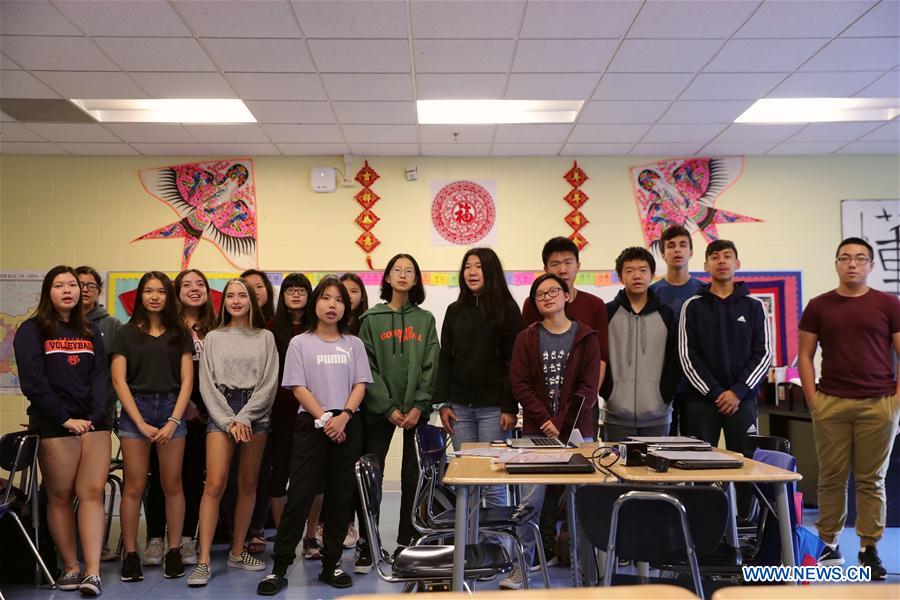
Students attend Chinese language class at Walter Payton College Preparatory High School in Chicago, the United States, on Sept. 24, 2019. (Xinhua/Wang Ping)
by Xu Jing, Wan Fang, Yang Haiyun
CHICAGO, Oct. 7 (Xinhua) -- Standing in front of the blackboard, Christina Xu announced the start of the class. Eighteen students stood up, shouted their greetings of "good morning" in Chinese, and started the 90-minute class.
This is a usual Chinese class at Walter Payton College Preparatory High School in downtown Chicago. The 18 students were divided into small groups, four in each group, to practice Chinese speaking and writing. "Look at the picture and speak," "tone practice," "dialogue," "compete to write," and "singing Chinese songs," diversified learning and practice methods have made the class anything but dull.
The four different tones are considered one of the most difficult parts in Chinese learning. To make it easier, Xu attached to each tone a gesture, and asked the students to give corresponding gestures to the words she pronounced. There were always students giving a wrong gesture to a word, drawing waves of laughter in the class.
In sentence composing section, the students were encouraged to write down as many Chinese sentences as they can. Chances were there were often strokes either to the left or to the right missing in a character. When Xu added the missed strokes together with humorous comments, the students laughed again and easily remembered the correct ones.
The students then sang together a Chinese Mid-Autumn Festival song, which goes "the moon is full, under which we are hand in hand with heart connected," in clear pronunciation and with smiling faces.
Walter Payton is one of the 41 public schools in Chicago that offer Chinese classes. Some 60 certified full-time Chinese teachers like Xu are offering Chinese courses in four levels to some 11,000 elementary and middle school students in Chicago Public Schools (CPS).
"CPS offers 12 foreign languages for students to choose. Compared with Spanish and French, Chinese is a late comer," Jane Lu, CPS Chinese world language coordinator and director of the Confucius Institute in Chicago, told Xinhua in an interview. "But in 2018, Chinese surpassed French to become the second most chosen foreign language."
Talking of the heat of Chinese language learning, Lu attributed it to the rapid development and rising of China on the world's stage. By choosing to learn Chinese, "the students are aiming at the potentials China has, and investing in the future."
Sixteen-year-old Steven Norinsky is a junior at Walter Payton. He started to learn Chinese in elementary school, and has kept learning ever since. "I plan to learn it throughout high school for the rest of my time here," he told Xinhua.
"I chose Chinese because I think it would be the most valuable language to learn," Norinsky explained. "It's more valuable to know a language that more people speak and especially the United States has a lot of relations with China."
Norinsky said he believes that learning Chinese will help him in his career in the future.
CPS started to offer Chinese as a second language option in 1999. Only several schools had Chinese classes until 2006, when the Confucius Institute in Chicago was established.
The institute is responsible for coordinating Chinese courses and training Chinese teachers in CPS. Establishment of the Confucius Institute has added wings to Chinese teaching in CPS, Lu told Xinhua.
The institute has not stopped on this. It sends more than 20 CPS students to China for exchange and study every year. "Only after having personal experiences of China would the students find a fair and objective knowledge about the country and share it with others," Lu stressed.
The office of the Confucius Institute in Walter Payton has put on display more than 10,000 Chinese books and audio and video products. All students from the school can walk in at any time to immerse themselves in Chinese culture or do homework. The office is also open to the public.
"Social demand" is the biggest driver behind the development of the Confucius Institute, Lu said. As the number of students learning Chinese keeps increasing, the demand for full-time Chinese teachers is also increasing. By training in-service Chinese teachers, the institute has led Chinese teaching in CPS into a "benign cycle."
Lu enjoyed her work very much. "Teaching Chinese and promoting China-U.S. friendship and culture and people-to-people exchange will be my life-long career," Lu said.